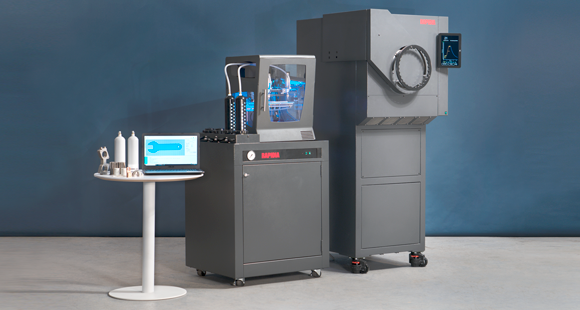New metal Additive Manufacturing process uses water as binder
April 4, 2019

Rapidia’s new metal Additive Manufacturing system and sintering furnace (Courtesy Rapidia)
Rapidia, based in Vancouver, British Columbia, Canada, has developed a new metal Additive Manufacturing system which uses a water based metal or ceramic paste fed through print heads, similar to those used in Fused Deposition Modelling (FDM) systems.
Unlike many other commercially available binder-based metal AM processes, which use polymer or wax-based binders, the company states that the use of a water-based binder eliminates the need for any debinding stage prior to sintering, helping reduce the overall processing time for each part. Rapidia also stated that the process does not require a base or raft, and in the majority of cases does not use metal support structures, reducing the amount of metal waste generated during the process.
Water-based metal paste is also said to be one of the safest and most environmentally friendly method of handling materials for Additive Manufacturing, as it allows a solvent-free AM workflow with no requirement for polymer disposal. No fumes or odours are created in the printer during printing, as the only material that evaporates is water.
In recent years, a number of metal Additive Manufacturing systems have been developed which use a bound metal feedstock, similar to that used in Metal Injection Moulding (MIM). The MIM process uses a polymer or hard wax binding agent to allow material injected into the mould to solidify in seconds, for rapid removal from the mould. However, Rapidia states that because the build process in metal Additive Manufacturing takes significantly more time than MIM, the use of a polymer or wax binding agent is not required – long build times allow a water-based binder to evaporate during the build.
“While Rapidia was not the first to consider this, it is the first company to bring to the market a complete solution utilising this process while adding several further advantages not possible with the polymer binding process,” the company stated. “The Rapidia system offers the lowest cost per part by saving the cost of the debinder and by using significantly less metal for making the same part compared to other systems.”
The Rapidia AM machine builds parts using two independent print heads, on a build plate of heated glass and build sheet of aluminium foil or polyester sheet. It has a part manufacturing envelope of 200 x 280 x 200 mm and can build parts to coarse (0.6 mm nozzle) and fine (0.4 mm nozzle) resolutions. According to the company, the machine has a build speed of over 40 cm3 per hour at coarse resolutions.
On its release, Rapidia’s machine will be compatible with seven metal materials and three ceramic materials, with more said to be in development. Described as an ‘office-friendly’ system, it is said to take up the same footprint as a stove and refrigerator. Its water-based binder technology also eliminates the need for a debinding unit to be installed in an office environment, which can be both highly costly and space-consuming.
Rapidia will showcase its technology at Rapid + TCT in Detroit, Michigan, USA, May 21–23, 2019.
















